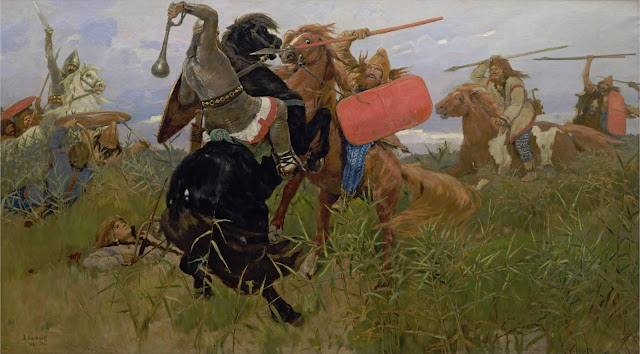Herodotus (4.110–117) tells us some Amazons were captured in battle by Greeks in Pontus (northern Turkey) near the river Thermodon, and the captives were loaded into three boats. They overcame their captors while at sea, but were not able sailors. The boats were blown north to the Maeotian Lake (the Sea of Azov) onto the shore of Scythia near the cliff region (today's southeastern Crimea). After encountering the Scythians and learning the Scythian language, the Amazons agreed to marry Scythian men, but only on the condition that they move away from Scythia and not be required to follow the customs of Scythian women.
Hippocrates described these warlike women.
"Their women, so long as they are virgins, ride, shoot, throw the javelin while mounted, and fight with their enemies. They do not lay aside their virginity until they have killed three of their enemies, and they do not marry before they have performed the traditional sacred rites. A woman who takes to herself a husband no longer rides, unless she is compelled to do so by a general expedition. They have no right breast, for while they are yet babies their mothers make red-hot a bronze instrument constructed for this very purpose and apply it to the right breast and cauterize it, so that its growth is arrested, and all its strength and bulk are diverted to the right shoulder and right arm."
Their descendants settled beyond the Tanais (Don) river and became the cultural group known to the Romans as Sarmatians. Strabo said the Sarmatians extended from above the Danube eastward to the Volga, and from north of the Dnieper River into the Caucasus and at some point had intermarried with the Thracians (7.3.2).
These "wagon-dwellers" and "milk eaters" wore long flowing robes similar to those of the Persians according to Tacitus and by the third century BCE, the Sarmatian name appears to have supplanted the Scythian in the plains of what now is south Ukraine.
With iron a rare commodity on the steppes, the eastern Sarmatians used bone and wood for weapons and armor made of horse's hooves. Pausanius, who found a Sarmatian breastplate among votive offerings near the Athenian Acropolis in the 2nd century CE, describes the process:
"Each man keeps many mares, since the land is not divided into private allotments, nor does it bear any thing except wild trees, as the people are nomads. These mares they not only use for war, but also sacrifice them to the local gods and eat them for food. Their hoofs they collect, clean, split, and make from them as it were python scales. Whoever has never seen a python must at least have seen a pine-cone still green. He will not be mistaken if he liken the product from the hoof to the segments that are seen on the pine-cone. These pieces they bore and stitch together with the sinews of horses and oxen, and then use them as breastplates that are as handsome and strong as those of the Greeks. For they can withstand blows of missiles and those struck in close combat."
They also used lassos during combat in which they would lasso an enemy then turn quickly to unseat the rider. Their weapons and tactics were formidable enough to defeat two Roman legions in Pannonia in late 374 CE as recorded by Ammianus Marcellinus. This was in spite of the fact that Sarmatians had previously served in the Roman army. In the fourth and fifth centuries when the Huns expanded and conquered both the Sarmatians and the Germanic tribes living between the Black Sea and the borders of the Roman Empire, the Sarmatians fought with the Huns against a combination of Roman and Germanic troops but their alliance was shattered at the brutal Battle of the Catalaunian Plains in 451 CE followed by the death of Attila two years later. The Sarmatians returned to their traditional homeland and were eventually assimilated and absorbed by Proto-Slavic tribes during the early Middle Ages.
I have greatly condensed key points in the rise and fall of the Sarmatians. I highly recommend reading much more about them here: https://weaponsandwarfare.com/2017/10/14/the-sarmatians/
 |
| Gold bridle ornament depicting a stag, Sarmatian, 5th-3rd century BCE, now in the collections of the Cleveland Museum of Art, image courtesy of the museum. |
 |
| Disc brooch, Sarmatian, c. 150-100 BC, gold, chalcedony, carnelian, courtesy of Wikimedia Commons contributor Daderot. |
 |
| Sarmatian cataphracts (who fought for the Dacians) during the Dacian Wars as depicted on Trajan's Column, 113 CE, courtesy of Wikimedia Commons. |
 |
| Oval brooch with intaglio of Athena, Sarmatian, c. 100 BC, gold, carnelian, garnet, rock crystal, glass, courtesy of Wikimedia Commons contributor Daderot. |
 |
| Battle between the Slavs and the Scythians (Sarmatians) — painting by Viktor Vasnetsov (1881), courtesy of Wikimedia Commons. |


No comments:
Post a Comment